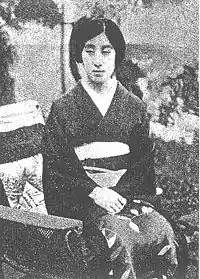Takeko Kujō
Takeko Kujō (九条 武子, Kujō Takeko, October 20, 1887 – February 7, 1928) was a humanitarian and founder of the Buddhist Women's Association in order to promote the status and solidarity of Buddhist women in Japan, and later overseas.
Takeko Kujō 九条 武子 | |
|---|---|
 Kujō Takeko | |
| Born | October 20, 1887 Kyoto, Japan |
| Died | February 7, 1928 (aged 40) |
| Nationality | Japan |
| Occupation | humanitarian, author |
Biography
Kujō was born in Kyoto as the daughter of Ōtani Kōson (Myōnyo), the 21st hereditary head of the Jōdo Shinshū branch of Japanese Buddhism.[1][2] Her elder brother, Ōtani Kōzui was the 22nd head of the sect, and a noted explorer of Central Asia, while another brother, was Ōtani Sonyu, was a politician who served in the House of Peers in the Diet of Japan. Her mother was a secondary wife, and the daughter of a samurai from Kii Domain. She was educated at the predecessor to the Kyoto Women's University.
In 1903, on the death of her father, she came into the care of her brother Kozui.[2] Her public life began during the Russo-Japanese War of 1904–1905, when she co-founded the Buddhist Women's Association,[1][2] which was active in sending care packages to soldiers at the front, and to helping families who had lost their sons in combat.
In 1909, she entered into an arranged marriage with Baron Kujō Yoshimasa, the brother of her sister-in-law. She went to England where her husband attended Cambridge University. She returned to Japan after one year, leaving her husband (who was later assigned to the branch of the Yokohama Specie Bank in London) behind. The couple lived apart for most of their lives.
After the 1923 Great Kantō earthquake which devastated Tokyo and the surrounding Kantō region, Kujō sponsored various humanitarian efforts, which led to the reconstruction of the Tsukiji Hongan-ji temple, and the foundation of Asoka Hospital, one of Japan's first modern medical centers.[2]
Kujō was also a noted poet, having studied under Nobutsuna Sasaki. She wrote numerous poems and gathas about her Nembutsu faith, publishing her first volume of poetry, Kinrei (金)鈴) in 1920, followed by a stage play Rakuhoku (洛北) in 1925. A second volume of poetry followed in 1928, Kunzen (薫染) and an autobiography, Shirokujaku (白孔雀) in 1930.
She died after developing sepsis during her work in one of Tokyo's poor districts. She is commemorated through memorial services conducted by Jōdo Shinshū temples in Japan and the United States.
References
- "History". San Jose Buddhist Church Betsuin. Retrieved May 13, 2013.
- "Kujo Takeko : A Modern Buddhist Woman". Shin Dharma Net. Archived from the original on November 30, 2009. Retrieved May 13, 2013.
- Kujo, Takeko. Muyuge: Flower Without Sorrow (The Nembutsu Press, Los Angeles, 1985)